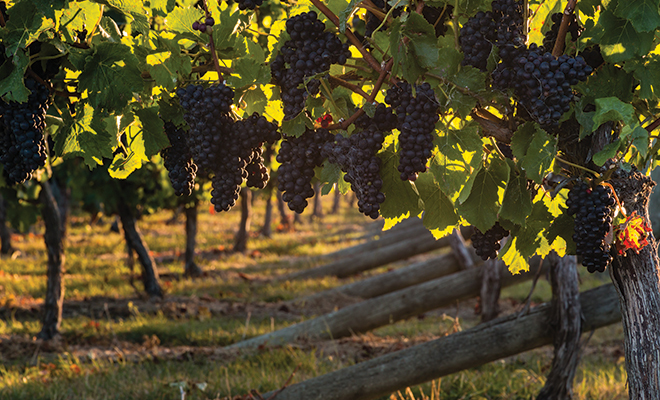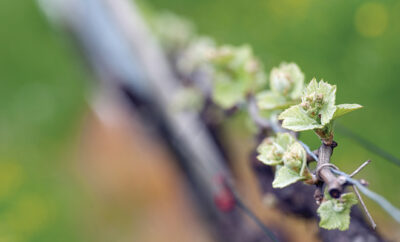
The Perfect Season for Pinot Noir
Raspberries. Wet river rock. Crushed mint leaves. Strawberries. Wilted baby greens. These ingredients may sound like a side salad from the tony bistro in midtown, but in actuality these are some of the characteristics of pinot noir.
In its perfect form, pinot noir is hardly a side dish. It’s exquisite, balanced and polarizing all at the same time. When you ask someone if she likes pinot noir, you usually get one of two responses: “Oh, yes, especially from the Russian River Valley,” or she wrinkles up her nose and politely says, “It’s not my favorite,” often citing a barnyard quality of her last pinot noir experience.
Originating in the Burgundy region of France, pinot noir grapes grow in a very tight cluster in the shape of a pine cone. As they thrive in the cooler regions of the world, we are mostly exposed to the exquisite wines of Willamette Valley of Oregon and the California regions of Carneros, Central Coast and Russian River. The 2004 movie Sideways salutes this varietal as the main character explores wine in the Santa Barbera area of Central California. This movie makes a wonderful fuss over a grape that is incredibly temperamental, moody and prone to surprises, similar to the movie’s protagonist.
Pinot wine grape growers commit to full-time babysitting when they embark on a successful harvest of quality grapes. Because the grape cluster grows so tightly, the cluster of thin-skinned grapes is prone to rot from moisture sitting in the nooks and crannies of the cluster. To prevent rot, the vines must be managed and pruned with a close eye and a loving hand. When this is successful, the juice of the pinot noir is a lighter red with low tannin quality.
Although there are varietal-specific qualities at the core of pinot noir, these regions contain nuances that make them special examples of a timeless varietal. Wine labels are designed to entice you to explore contents of the bottle; when these regions are listed on the label, you can anticipate region-specific qualities based on their terroir. Although specific winemakers are artisans in this art form, these regions reflect some unique characteristics.
Willamette Valley, Oregon, produces an earthier quality of pinot noir that nearly transports you to the vineyard itself. The soil qualities enhance both fragrance and flavor, balanced with subtle berry flavors.
Russian River, California, vineyards grow in a sandy soil and enjoy early morning fog with warm afternoon breezes from the Pacific Ocean. These pinots have a mid-range ruby color, exotic spices, cherry on the front of the palate and a long finish.
A fragrance of violet can be the primary sense of pinot noir from the Carneros region of California, with a spicy berry finish, fresh earthiness and balance. Napa and Sonoma are contained in the Carneros region north of the San Pablo Bay.
Central Coast terroir encompasses six counties along the coast of California, where influences from the Pacific Ocean keep these vineyards cool, providing a consistent and moderate growing season. With a lighter shade of garnet, these pinots often present a bit of white pepper with subtle fragrance and flavors of anise and earth.
Because of the delicate nature of pinot noir, I keep my bottles stored in the low 50s and out of light. Rather than the tall, slender, broad-shouldered bottle for cabernet or malbec, the bottle shape of pinot noir has a low shoulder and larger base similar to a chardonnay bottle. To keep these bottles stacked safely, use a slotted wine rack that supports each bottle to prevent slippage and potential breakage.
Every season seems to have its particular wine varietal. In fall and winter, we gravitate toward the robust spice and warmth of cabernet franc, petite sirah and barbera. When spring arrives, the farmers’ market produce changes, air has fresh scents and life that is well timed for pinot noir. Try pinot noir this spring with lamb, salmon and finely cured meats from your favorite delicatessen. Your favorite baked chicken recipe with spring vegetables, sage and butter sauce is the perfect gateway to enjoying a lovely pinot noir.
In my opinion, we Americans tend to serve our red wines a bit too warm. For European wine lovers, room temperature is fairly chilly when we consider the multi-generational stone residences that may not have central heat. Chances are your pinot noir will benefit from about 20 minutes in the refrigerator before serving.
Finally, enjoy your pinot noir in a quality glass. This grape is thin skinned, delicate and filled with a sense of place, sharing the unique essences of soil, rainfall, fog and temperature where it’s grown. Although many red wines have their perfect stemware, this is most true for me with pinot noir; I enjoy it in a fine crystal glass with a large bowl which, believe it or not, balances the sweetness with the acid and provides a perfect sip. ■
Sources: moviefone.com and wineenthusiast.com.







